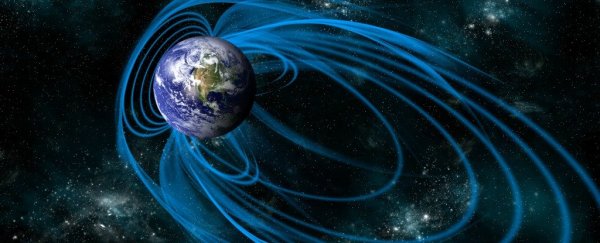Earth's magnetic field is pretty adept at flipping polarity. The poles have swapped, reversing north and south, many times over the planet's history.
Within the last 20 million years, Earth has fallen into the pattern of pole reversal every 200,000 to 300,000 years, and between successful swaps, the poles sometimes even attempt to reverse and then snap back into place.
About 40,000 years ago, the poles made one such unsuccessful attempt, and the last full swap was about 780,000 years ago, so we're a bit overdue for a pole reversal based on the established pattern.
The planet's magnetic field is already shifting, which could signify the poles are preparing to flip, and while we can't yet confirm that a reversal is on the near horizon, it is well within the realm of possibility.
While a pole reversal isn't entirely uncommon when you consider Earth's history, this time it could have serious implications for humanity.
To try to determine whether or not a flip is imminent, scientists have begun using satellite imagery and complex calculations to study the shifting of the magnetic field.
They've found that molten iron and nickel are draining energy from the dipole at the edge of the Earth's core, which is where the planet's magnetic field is generated.
They also found that the north magnetic pole is especially turbulent and unpredictable. If the magnetic blocks become strong enough to sufficiently weaken the dipole, the poles will officially switch.
Again, while it is not a certainty that the switch will happen soon, this activity at the Earth's core suggests that it is possible in the near future. So, how might a pole switch impact our lives?
The Earth's magnetic field protects the planet from solar and cosmic rays. When the poles switch, this protective shield could diminish to as little as one-tenth of its typical ability.
The switching process could take centuries, and the entire time, radiation would be able to get closer to the planet than usual.
Eventually, this radiation could reach the surface of the Earth, rendering some regions uninhabitable and causing entire species to go extinct.
Before that happened, though, a weakened magnetic field would likely impact orbiting satellites, which have suffered from memory failure and other damage when exposed to such radiation in the past.
Damage to satellites caused by decreased protection from the magnetic field could affect the satellite timing systems that control electric grids.
These grids could fail, leading to worldwide blackouts that experts predict could last for decades.
Without functioning electric grids, we couldn't use cell phones, household appliances, and so much more. The sudden blackouts would have hospitals scrambling for backup power sources, putting countless lives at risk.
GPS technology would also be compromised, affecting everything from military operations to our ability navigate our cars.
Additionally, we are becoming more reliant on technology by the day, with autonomous vehicles, artificial intelligence (AI), and other innovations all advancing rapidly.
By the time a pole switch did take place, these innovations could be a regular part of our daily lives, furthering the potential for disruption.
It's true that we live in an age where data rules all. From how we communicate to how we get around to how our governments and critical facilities run, it all comes down to how we send and store data, so if the world's satellites are damaged or rendered nonfunctional, life as we know it could forever change.
But this isn't a doomsday prediction. While the poles will inevitably flip again at some point, our ability to recognise this possibility in advance allows us to prepare for it.
For starters, satellite companies can begin to collaborate, sharing ideas with one another on how to equip satellites to deal with a pole reversal.
Government and university researchers can focus their efforts on developing new satellites specifically designed to withstand extreme radiation and space weather.
Governments, businesses, and communities can come together to form action plans.
They can find ways to store energy and ensure the public is educated on the subject of pole reversal, so that when it happens, the situation won't cause widespread panic.
Earth's poles have been switching for millions of years, and they will continue to do so for the foreseeable future. The best thing we can do is prepare now so we're ready the next time it happens.
This article was originally published by Futurism. Read the original article.
